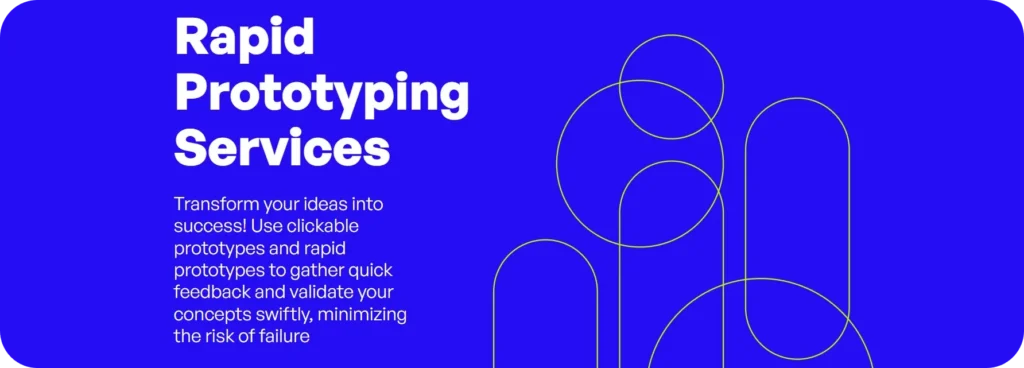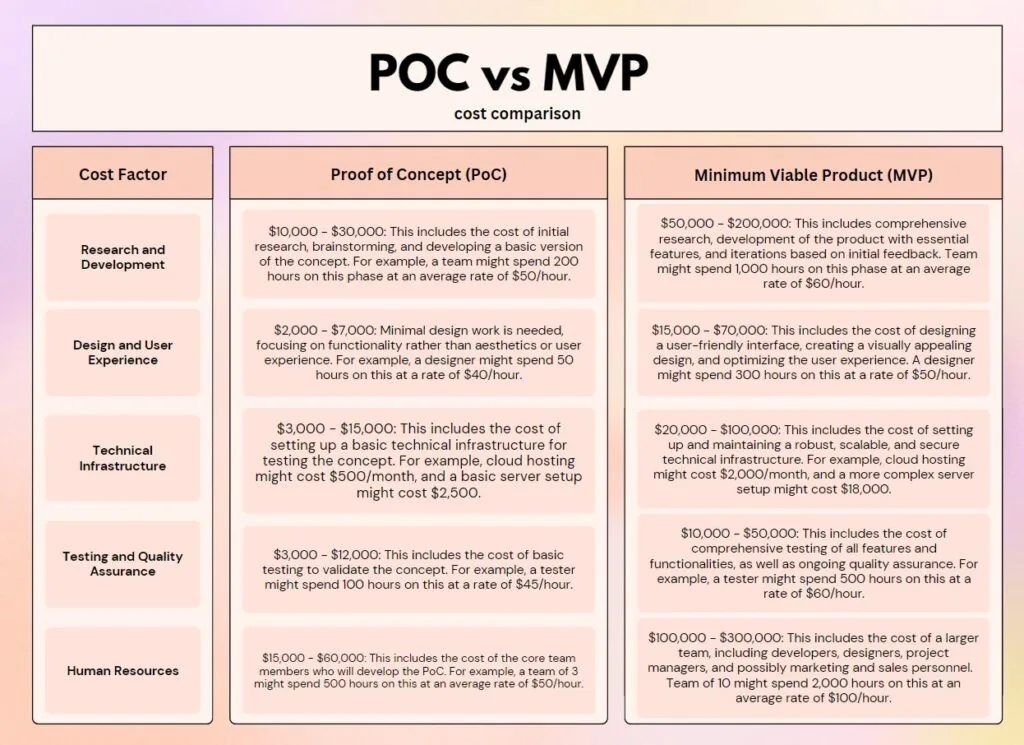Proof of Concept vs Prototype: A Detailed Breakdown
You've likely heard the terms "Proof of Concept" vs "Prototype" if you've been anywhere near the world of product development or technology. But what do they mean? More importantly, when should you use each? Understanding these concepts is like acquiring the keys to unlock the door of successful innovation. In the following sections, we’ll peel back the layers to see what makes a Proof of Concept different from a Prototype, and vice versa.

Table of content
Table of Contents
Business Success Starts Here: Opt for our Proof of Concept service to test your ideas effectively!
Contact Us Let’sTalk
You’ve likely heard the terms “Proof of Concept” vs “Prototype” if you’ve been anywhere near the world of product development or technology. But what do they mean? More importantly, when should you use each? Understanding these concepts is like acquiring the keys to unlock the door of successful innovation. In the following sections, we’ll peel back the layers to see what makes a Proof of Concept different from a Prototype, and vice versa.
What is a Proof of Concept?
Immerse yourself in the concept of a real-world simulation, a tangible representation that captures the essence of a product, an attribute, or an innovative design, encapsulating its utility in a plausible scenario, hence asserting its problem-solving prowess. Its technical moniker? POC – a term encountered frequently in documents that delve into design intricacies.
Venturing into the realm of user experience design, the term POC morphs into a rudimentary representation of an innovative product or an avant-garde feature. It dons the role of a theatre stage, offering a sneak peek into the product’s functionality under conditions mimicking reality. Not just that, it convincingly elucidates the user’s problem-solving capacity, painting a vivid picture of its utility.
The inception of a POC usually aligns with the necessity of persuading a client or superiors about the viability of a fresh idea. It provides a glimpse into the potential appearance and functionality of the proposed product or feature, stirring their imagination.
The tools to craft a POC are as diverse as the ideas it encompasses. Software like Photoshop or Sketch bring these ideas to life digitally. In a more analog approach, sticky notes or whiteboards transform into canvases, capturing these embryonic ideas through a visual narrative.
Defining a Product Proof of Concept
In the world of innovative thinking, there’s a key tool known as a ‘proof of concept’ (POC). This is a rough version of a potential product or feature, shown in a real setting. It showcases how it works and its potential to solve user problems. A POC is important for convincing others, like your boss or client. It helps them visualize the potential product or feature, sparking their imagination and guiding them towards your idea. Creating a POC can involve complex software like Photoshop or Sketch, transforming digital ideas into visual form. Or, it could involve simpler methods, like sticky notes or a whiteboard to visualize your ideas.
What is a Prototype?
Immerse yourself in the realm of prototypes – tangible creations or simulations, representing a product, feature, or design, showcasing their functionality under real-life conditions. They bear the identifiers ‘RP’ or ‘RTD’, signaling the return on design investment.
But a prototype isn’t just a mere idea brought to life. It ascends beyond a proof of concept, embodying functionality. It doesn’t just pose a hypothetical solution, it enables a user to complete an actual task, demonstrating the practical usage of your product or feature.
Consider a prototype as an evolution of a POC. It’s more refined, more representative of the final product, and it invites real user interaction and testing. It allows for exploration of your product or feature’s functionality, revealing any design anomalies that might need to be addressed.
Crafting a prototype might involve an intricate dance with sophisticated software such as Axure or Framer, translating digital musings into visual reality. Alternatively, it could embrace a more tactile approach, deploying resources like paper or digital tools such as Sketch to devise a wireframe, which then is infused with life through motion.

Why Is It Important to Distinguish Between a Proof of Concept vs Prototype?
Proofs of concept (POCs) and prototypes are key steps in innovative design. A POC is a basic plan, showing how a product or feature could work in real-life. It solves user problems. A prototype, though, goes further. It’s a polished model, looking much like the final product, and ready for real user testing.
A POC helps convince clients or bosses about your idea. It gives a glimpse of the potential look and operation of the product or feature, sparking their imagination.
The prototype is the next step. It’s a more developed version of the POC, showing how the product or feature might function in real-life and proving its ability to meet user needs. The prototype helps spot and fix design flaws and can be tested by users for useful feedback.
Differences between a Proof of Concept vs Prototype
Let’s tread into the territories of proof of concept (POC) vs prototype, two entities connected yet distinct. A POC is akin to a conceptual sketch, a rough approximation of a product or feature, illustrating its potential functionality within a real-world framework and validating its problem-solving potential for your users.
Conversely, a prototype emerges as an advanced rendition of a POC. It portrays a more sophisticated mock-up of a product or feature, vividly showing its workings in a scenario that mirrors real life, and substantiating how it can address user-specific challenges.
A prototype paves the way for detailed testing of your feature or product, unveiling any design discrepancies or functional roadblocks that need to be resolved. It extends an invitation to the user to interact with it, akin to app testing, offering a glimpse into its practical usability. A POC, while critical, doesn’t scale the advanced stage required for such detailed user testing.
In the intricate journey of developing a product from a simple idea to a tangible, marketable commodity, product teams often face the critical decision of choosing between a Proof of Concept (PoC) and a Minimum Viable Product (MVP). The PoC vs MVP decision is a significant pivot point in product development, with implications that extend beyond mere concept and prototype; they also directly influence the allocation and magnitude of the project’s financial resources.
Analysis of Costs for Proof of Concept (PoC) vs Minimum Viable Product (MVP) in Product Development
A PoC project comes into play in the initial stages of a project, aptly named the ‘PoC stage’. This phase focuses on the scientific validation of a concept or prototype. In other words, the PoC approach seeks to answer the question: “Can we build this product?” The aim here is to demonstrate the technical feasibility of the product idea, ensuring the core functionality can indeed be developed and function as expected. Since the PoC primarily revolves around a bare-bones, technical representation of the idea, the costs involved in this stage are generally lower. This stage is characterized by rapid prototyping, a cost-effective and swift method to validate the concept’s feasibility before progressing to more complex and costly stages.

The MVP, on the other hand, is a different beast altogether. While the MVP also serves as a prototype, its aim is much more comprehensive, answering the question: “Should we build this product?” An MVP represents a basic yet functional version of the product, with enough features to make it usable by early adopters. It’s an elaborate effort to achieve the right product market fit from an early stage. Thus, creating an MVP involves more detailed planning, development, and refinement, leading to higher costs. It integrates the essential features that potential users will interact with, providing a mechanism for early user feedback and allowing for more thorough and reliable idea validation.
Comparing the PoC and MVP approaches, it’s clear that the cost implications are distinct and significant. A PoC approach might limit the initial expenditure, making it seem more cost-effective at the beginning of a project. However, an MVP, despite its higher upfront costs, can potentially provide better long-term value. By aligning the product with market needs from an early stage, MVP development can prevent costly pivots or reworks later in the product’s life cycle. So, while the initial investment is higher, the MVP approach could prove to be more cost-effective in the long run, offering a more pragmatic route to the successful conversion of a product idea into a market-ready product.
Prototype vs MVP: Navigating the Crucial Stages of Software Development
Understanding the difference between a prototype and a Minimum Viable Product (MVP) can greatly enhance the process of software development, especially when developers are working on a mobile app prototype. A prototype is essentially the very first version of a software or product. It demonstrates how the final product might look and function but is not necessarily a fully functioning model. For instance, in extreme prototyping, a process often used in the web development domain, developers create a series of rapidly developed mock-ups to validate the design, architecture, and usability of a software solution before significant resources are invested.
On the other hand, an MVP is a product that includes the bare minimum features necessary to solve a customer’s problem and provide value. It’s not just a visualization tool; it’s the first practical version of a product that is ready for use by early adopters. Often, the concepts of PoC (Proof of Concept) vs Prototype are brought into discussion. While a PoC is meant to prove that the concept is feasible technically, an MVP is designed to understand if the product has market viability.
Thus, both the prototype and the MVP are integral steps in the software development process, guiding developers from a basic visualization to a final product that is ready for launch. However, they serve different purposes: prototypes are about testing design, functionality, and feasibility, while MVPs are about testing the market fit and user interest in a more fully-realized version of the product.
Proof of Concept vs Prototype: Bottom line
A proof of concept (POC) is an initial demonstration of a product or feature’s potential to solve user problems. However, a prototype is a more refined and practical simulation of the product or feature, providing a clear view of its real-world operation. The POC aims to convince stakeholders about a novel idea by showing its possible look and function, while a prototype is a more polished, user-test ready version of a POC, closely reflecting the final product.


